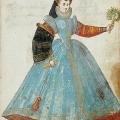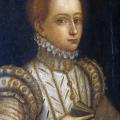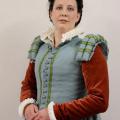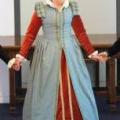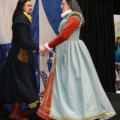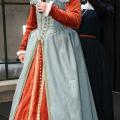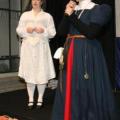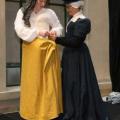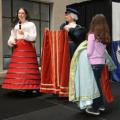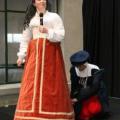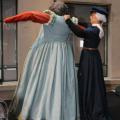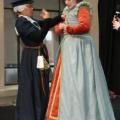You are here
1570s French Court Gown
I worked on this outfit for six months to get it completed. The forepart and sleeves are made of a burnt orange cotton velvet, lined with linen, while the dress is made of duck egg blue wool, partially lined with pale green silk and fully lined in linen. The partial silk lining is on the dress skirt, so that when I am turning or spinning when I dance the silk is revealed, rather than the linen.
I spent a lot of time looking at portraiture and images of clothing from the time, but I'll only mention a key few here.
The colours are based on later images from the Album Amicorum, as I was really taken by how vivid the contrast was. One of the things I love about French garb is how fantastically colourful it can be, and I really wanted to make use of that.
The shoulder rolls were primarily based on the above c.1570 Clouet portrait, while for the fullness of the skirts and the drape at the back I relied on the Valois tapestries of the era.
I also used the information in Janet Arnold about the black velvet doublet with the padded shoulder rolls to help figure out what I was doing.3 They were the most difficult point of the construction: I ended up doing these at least four times. At least now I have a good idea of how they're constructed, and would feel much more confident making them again, or guiding someone else through making them! I'm still not 100% satisfied with the finished rolls, but that just gives me something to develop further on the next dress.
I also used the cut and shaping of the bodices of the high-necked gowns in Janet Arnold to help guide the shaping of my own bodice,4 although I did draft it from scratch using my measurements and with the help of modern pattern-drafting tools as well, and altered the shaping to be in keeping with that of French portraiture of the time.
I made all the buttons by hand, covering small wooden beads with thread. I have yet to add more onto the shoulder rolls as in the Clouet above. I couldn't find an appropriate braid to trim the dress with, so used a green bias-cut silk tape as the base and made fingerloop braid to embellish this with. I could swear that I based the trim on a period example but haven't been able to find it again since, although I still am keeping an eye out for it.
Since making the dress, I have refined the way the sleeves lace on slightly.
Below are some images of the complete outfit, taken at a demonstration at the Auckland Museum and also at a demonstration at a local church.5 One of the most disappointing things about the outfit is that, during the time it took to make the outfit (six months or more) I put on 5kg which I have yet to lose, so the outfit has never fit the way it did when I did the last of the fitting prior to completion.
As part of the demonstration at the Auckland Musuem, I got dressed on stage. For decency's sake, I started out in hose & shoes, high-necked chemise, and corset (I desparately need to make a new corset due to aforementioned weight gain). For practicality's sake, my hair was already done. Below is the progression of getting dressed on stage, with help from Lady Anna de Wilde and members of the audience. I felt a bit sorry for the wee girl who got to hold the dress until I put it on: the dress itself weighs 5kg.
For headgear, I started out wearing a 1570s veiled headdress that I had made. However, I have since made a hat from the same era in the same burnt orange velvet, and now tend to prefer to wear this with the outfit.
1. http://collectionsonline.lacma.org/MWEBimages/C_t02_mm/full/M91_71_16.jpg accessed 16/03/2010
2. http://blog.silive.com/homegarden_impact_antiques/2009/09/webwoman9179.jpg accessed 16/03/2010
3. Janet Arnold Patterns of Fashion: The cut & construction of clothes for men and women c1560-1620 (London, Macmillan, 1985) pp42-43, pp107-108
4. Ibid, pp47-48, pp113-116
5. Photos courtesy of Eleanor Hall/Nicola Haliday and Christine Bess Duvant/Chantelle Gerrard
- Log in to post comments

